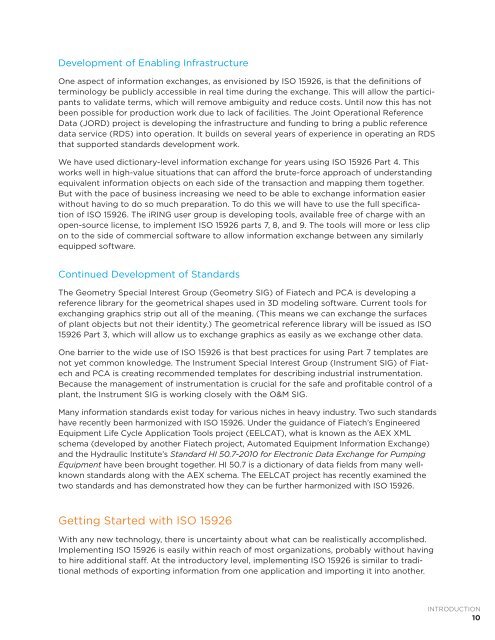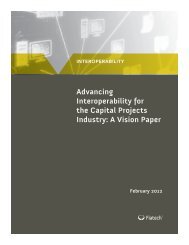An Introduction to ISO 15926 November 2011 - iRINGToday
An Introduction to ISO 15926 November 2011 - iRINGToday
An Introduction to ISO 15926 November 2011 - iRINGToday
You also want an ePaper? Increase the reach of your titles
YUMPU automatically turns print PDFs into web optimized ePapers that Google loves.
Development of Enabling Infrastructure<br />
One aspect of information exchanges, as envisioned by <strong>ISO</strong> <strong>15926</strong>, is that the definitions of<br />
terminology be publicly accessible in real time during the exchange. This will allow the participants<br />
<strong>to</strong> validate terms, which will remove ambiguity and reduce costs. Until now this has not<br />
been possible for production work due <strong>to</strong> lack of facilities. The Joint Operational Reference<br />
Data (JORD) project is developing the infrastructure and funding <strong>to</strong> bring a public reference<br />
data service (RDS) in<strong>to</strong> operation. It builds on several years of experience in operating an RDS<br />
that supported standards development work.<br />
We have used dictionary-level information exchange for years using <strong>ISO</strong> <strong>15926</strong> Part 4. This<br />
works well in high-value situations that can afford the brute-force approach of understanding<br />
equivalent information objects on each side of the transaction and mapping them <strong>to</strong>gether.<br />
But with the pace of business increasing we need <strong>to</strong> be able <strong>to</strong> exchange information easier<br />
without having <strong>to</strong> do so much preparation. To do this we will have <strong>to</strong> use the full specification<br />
of <strong>ISO</strong> <strong>15926</strong>. The iRING user group is developing <strong>to</strong>ols, available free of charge with an<br />
open-source license, <strong>to</strong> implement <strong>ISO</strong> <strong>15926</strong> parts 7, 8, and 9. The <strong>to</strong>ols will more or less clip<br />
on <strong>to</strong> the side of commercial software <strong>to</strong> allow information exchange between any similarly<br />
equipped software.<br />
Continued Development of Standards<br />
The Geometry Special Interest Group (Geometry SIG) of Fiatech and PCA is developing a<br />
reference library for the geometrical shapes used in 3D modeling software. Current <strong>to</strong>ols for<br />
exchanging graphics strip out all of the meaning. (This means we can exchange the surfaces<br />
of plant objects but not their identity.) The geometrical reference library will be issued as <strong>ISO</strong><br />
<strong>15926</strong> Part 3, which will allow us <strong>to</strong> exchange graphics as easily as we exchange other data.<br />
One barrier <strong>to</strong> the wide use of <strong>ISO</strong> <strong>15926</strong> is that best practices for using Part 7 templates are<br />
not yet common knowledge. The Instrument Special Interest Group (Instrument SIG) of Fiatech<br />
and PCA is creating recommended templates for describing industrial instrumentation.<br />
Because the management of instrumentation is crucial for the safe and profitable control of a<br />
plant, the Instrument SIG is working closely with the O&M SIG.<br />
Many information standards exist <strong>to</strong>day for various niches in heavy industry. Two such standards<br />
have recently been harmonized with <strong>ISO</strong> <strong>15926</strong>. Under the guidance of Fiatech’s Engineered<br />
Equipment Life Cycle Application Tools project (EELCAT), what is known as the AEX XML<br />
schema (developed by another Fiatech project, Au<strong>to</strong>mated Equipment Information Exchange)<br />
and the Hydraulic Institute’s Standard HI 50.7-2010 for Electronic Data Exchange for Pumping<br />
Equipment have been brought <strong>to</strong>gether. HI 50.7 is a dictionary of data fields from many wellknown<br />
standards along with the AEX schema. The EELCAT project has recently examined the<br />
two standards and has demonstrated how they can be further harmonized with <strong>ISO</strong> <strong>15926</strong>.<br />
Getting Started with <strong>ISO</strong> <strong>15926</strong><br />
With any new technology, there is uncertainty about what can be realistically accomplished.<br />
Implementing <strong>ISO</strong> <strong>15926</strong> is easily within reach of most organizations, probably without having<br />
<strong>to</strong> hire additional staff. At the introduc<strong>to</strong>ry level, implementing <strong>ISO</strong> <strong>15926</strong> is similar <strong>to</strong> traditional<br />
methods of exporting information from one application and importing it in<strong>to</strong> another.<br />
INTRODUCTION<br />
10



